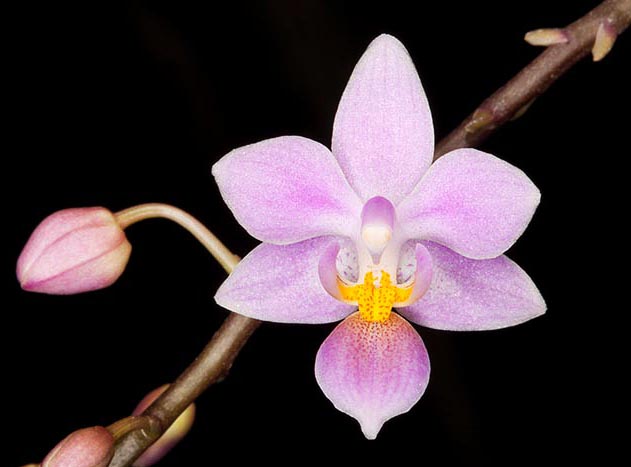Family : Orchidaceae

Text © Pietro Puccio

English translation by Mario Beltramini

Phalaenopsis equestris inflorescences reach the 30 cm with 1,5-3 cm flowers © Giuseppe Mazza
The name of the genus is the combination of the Greek terms “phalaina” = butterfly and “opsis” = appearance, with obvious reference; the name of the species is the Latin term “equestris” = equestrian, of unclear reference, as the same has not been specified by the author.
Common names: horse Phalaenopsis (English).
The Phalaenopsis equestris (Schauer) Rchb.f. (1850) is an epiphytic species with short stem hidden by the imbricate foliar bases and fleshy leaves, oblong-ovate or elliptic, 10-25 cm long and 5-6 cm broad.
Lateral racemose or paniculate inflorescences, arcuate, 20-30 cm long, carrying on a purple rachis several small flowers, of 1,5-3 cm of diameter, of rather variable shape and colour, with sepals and petals from white to pink with intense pink trilobed labellum with yellow dot at the base, at times speckled of red, and on the lateral lobes. Dorsal, ovate-elliptic sepal, 1-1,6 cm long and 0,5-0,8 cm broad, similar lateral sepals, bent backward, petals from elliptic to rhomboidal, 0,8-1,5 cm long and 0,5-0,8 cm broad, prominent labellum, 1-1,4 cm long and 1-1,6 cm broad with oblong-obovate lateral lobes bent upward and median lobe from ovate to elliptic, pointed and fleshy at the apex, arcuate column about 0,8 cm long.
It reproduces by seed, in vitro, by micropropagation and, at amateur level, through the young plants which often form at the base of the ramifications and at the apex of the inflorescence by the end of the seasonal flowering (in jargon, “keiki”, which in Hawaiian means “sons”), which may be taken off when they have formed a good rooting apparatus. Very floriferous species and easy to cultivate with long lasting flowers on inflorescences which may remain active even for more years, they are, therefore, not to be cut unless when dry; due to the facility with which it ramifies is widely utilized in the hybridizations for conferring this characteristic. It requires medium-high temperatures, with lowest winter values not under the 15 °C, much luminous position, in order to favour the flowering, and high humidity, 70-80%.
In spring-summer, during the vegetative period, the waterings must be regular and abundant, but allowing the roots to dry up before giving water again, reduced in winter in way to grant the plant a period of rest, stagnations at the axil of the leaves are to be avoided, especially during the night and with medium-low temperatures, a constant, good ventilation is fundamental in order to prevent rottenness. For the waterings and the nebulisations is to be utilized rainwater, or water obtained by reverse osmosis or demineralised; the fertilizations, duly distributed and alternated, in way to avoid salts accumulation at the roots, are to be done during the vegetative period preferably with hydro-soluble balanced products, with microelements, at ¼ of the dosage suggested on the package. It can be mounted on trunks, bark, cork raft or cultivated in pots, also hanging, with much draining and aerated compost which may be formed by medium-sliced bark fragments, with possible addition of inerts in order to improve the drainage. Any repottings are to be done, when strictly necessary, by the vegetative restart.
The species is reported into the appendix II of the CITES (species whose trade is internationally ruled).
Synonyms: Stauroglottis equestris Schauer (1843); Phalaenopsis rosea Lindl. (1848); Phalaenopsis riteiwanensis Masam. (1934); Stauroglottis riteiwanensis (Masam.) Masam. (1934); Phalaenopsis equestris var. rosea Valmayor & D.Tiu (1983); Phalaenopsis equestris f. alba (H.R.Sweet) Christenson (2001); Phalaenopsis equestris f. aurea Christenson (2001); Phalaenopsis equestris f. cyanochila O.Gruss (2001).
→ For general notions about ORCHIDACEAE please click here.
